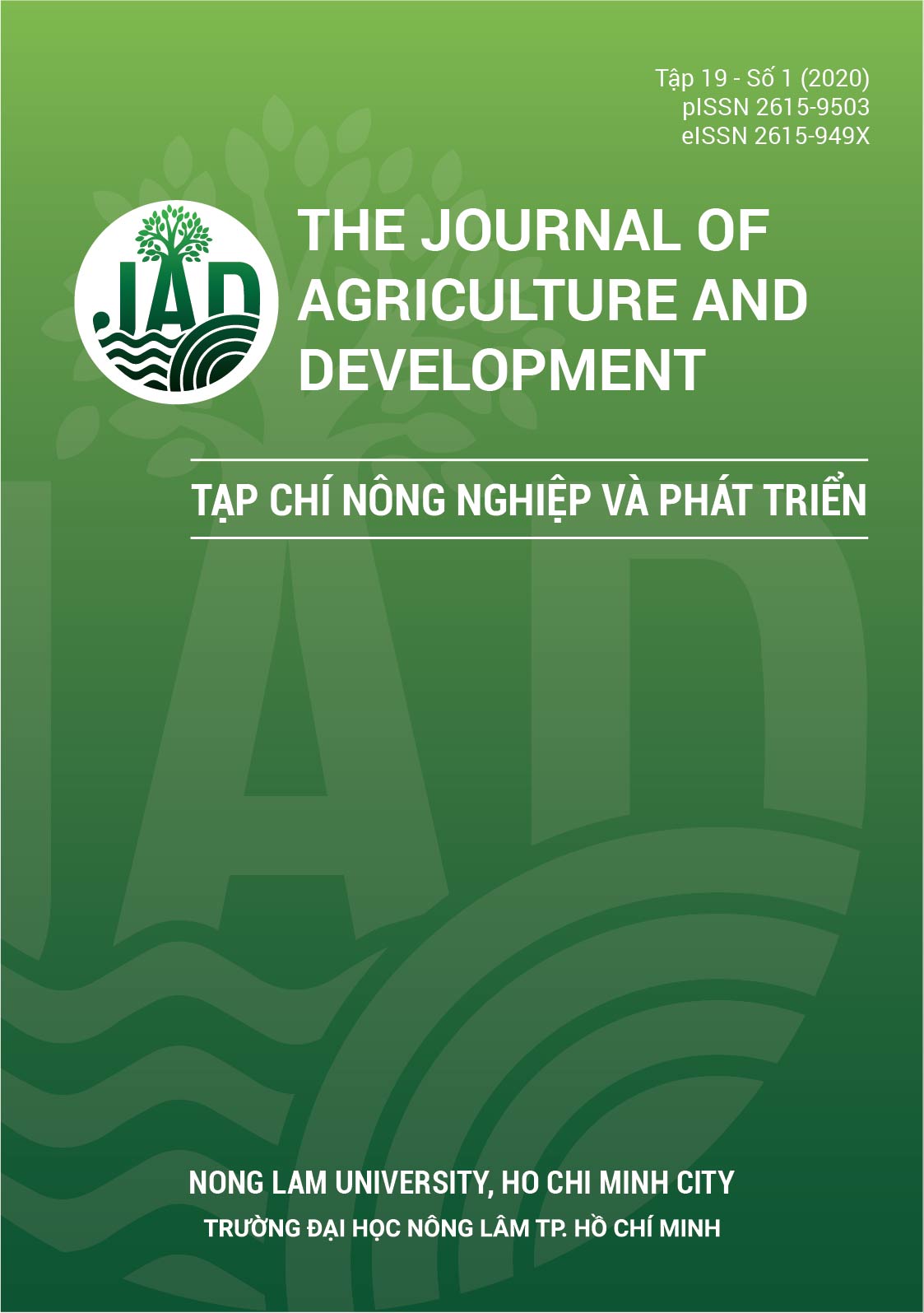Ảnh hưởng của loại và nồng độ alginate lên đặc tính vi bọc tinh dầu chanh (Citrus aurantifolia) bằng phương pháp nhỏ giọt kim tiêm
Main Article Content
Tóm tắt
Vi bọc tinh dầu chanh bằng phương pháp nhỏ giọt kim tiêm tạo hạt Alginate-Ca đã được thực hiện trong nghiên cứu này. Khoảng nồng độ alginate khảo sát là 1 - 4%. Ở nồng độ alginate trên 1%, dịch có độ nhớt dạng pseudoplastic. Kích thước (1,52 - 1,57 mm) và độ cầu hạt (trên 95%) đạt cực đại ở nồng độ alginate 2 - 3%. Phương pháp nhỏ giọt kim tiêm không phù hợp khi nồng độ alginate trên 3,5% do độ nhớt dịch quá cao dẫn đến độ cầu thấp. Hai loại alginate của Trung Quốc có hàm lượng đạm 9% (alg1) và 2% (alg2) có cùng hiệu suất vi bọc 73 - 74%. Tuy nhiên, hiệu suất thu hồi chất rắn alg2 đạt 98,99% cao hơn nhiều so với alg1 chỉ 52,17%. Điều này do alg2 có độ tinh khiết cao hơn và nếu chọn sử dụng trong thực tế sản xuất thì dễ kiểm soát hàm lượng và giảm lượng chất thải hữu cơ gây hại môi trường so với alg1.
Article Details
Tài liệu tham khảo
Anitha, K., Ramachandran, T., Rajendran, R., & Mahalakshmi, M. (2011). Microencapsulation of lemon grass oil for mosquito repellent finishes in polyester textiles. Elixir Bio Physics 40, 5196-5200.
Chan, E. S. (2011). Preparation of Ca-alginate Beads containing high oil content: influence of process variables on encapsulation efficiency and bead properties. Carbohydrate Polymers 84(4), 1267-1275. https://doi.org/10.1016/j.carbpol.2011.01.015
Chan, E. S., Lee, B. B., Ravindra, P., & Poncelet, D. (2009). Prediction models for shape and size of ca-alginate macrobeads produced through extrusion-dripping method. Journal of Colloid and Interface Science 338(1), 63-72. https://doi.org/10.1016/j.jcis.2009.05.027
Kausadikar, S., Ashish, D. G., & Jyotsna, W. (2015). Microencapsulation of lemon oil by spray drying and its application in flavour tea. Advances in Applied Science Research 6(4), 69-78.
Lewis, M. J. (2006.) Physical properties of foods and food processing systems. Sawston, England: Woodhead Publishing.
Martins, I. M., Barreiro, M. F., Coelho, M., & Rodrigues, A. E. (2014). Microencapsulation of essential oils with biodegradable polymeric carriers for cosmetic applications. Chemical Engineering Journal 245, 191-200. https://doi.org/10.1016/j.cej.2014.02.024
Mohsenin, N. N. (1970). Physical properties of plant and animal materials. New York, USA: Gordon and Breach Science Publishers.
Park, S. J., Shin, Y. S., & Lee, J. R. (2001). Preparation and characterization of microcapsules containing lemon oil. Journal of Colloid and Interface Science 241(2), 502-508. https://doi.org/10.1006/jcis.2001.7727
Paulo, B. B., Ramos, F. D. M., & Prata, A. S. (2017). An investigation of operational parameters of jet cutting method on the size of Ca-alginate beads. Journal of Food Process Engineering 40(60), 1-8. https://doi.org/10.1111/jfpe.12591
Poncelet, D., Babak, V. G., Neufeld, R. J., Goosen, M. F. A., & Burgarski, B. (1999). Theory of electrostatic dispersion of polymer solutions. Advances in Colloid and Interface Science 79(2-3), 213-228. https://doi.org/10.1016/S0001-8686(97)00037-7
PruBe, U., Bilancetti, L., Bučko, M., Bugarski, B., Bukowski, J., Gemeiner, P., Lewinska, D., Manojlovic, V., Massart, B., Nastruzzi, C., Nedovic, V., Poncelet, D., Siebenhaar, S., Tobler, L., Tosi, A., Vikartovska, A., Vorlop, K. D. (2008). Comparison of different technologies for alginate beads production. Chemical Papers 62(4), 364-374. https://doi.org/10.2478/s11696-008-0035-x
PruBe, U., Ulrich, J., Peter, W., Jurgen, B., & Klaus-Dieter, V. (2002). Bead production with JetCutting and rotating disc/nozzle technologies. In PruBe, U. & Klaus-Dieter, V. (Eds.). Practical Aspects of Encapsulation Technologies Proceedings on 2001, Braunschweig, Germany.
Soliman, E. A., El-Moghazy, A. Y., El-Din, M. S. M., & Massoud, M. A. (2013). Microencapsulation of essential oils within alginate: Formulation and in vitro evaluation of antifungal activity. Journal of Encapsulation and Adsorption Sciences 3(1), 48-55. 10.4236/jeas.2013.31006
Wandrey, C., Artur, B., & Stephen, E. H. (2010). Materials for Microencapsulation. In Nicolaas, J. Z., & Nedovic, A. V. (Ed.). Encapsulation technologies for active food ingredients and food processing. (31-100). New York City, America: Springer Publication.
Wandrey, C., Bartkowiak, A., & Harding, S. E. (2010). Materials for microencapsulation. In Nicolaas, J. Z., & Nedovic, A. V. (Eds.). Encapsulation technologies for active food ingredients and food processing (31-100). New York, USA: Springer. https://doi.org/10.1007/978-1-4419-1008-0_3








